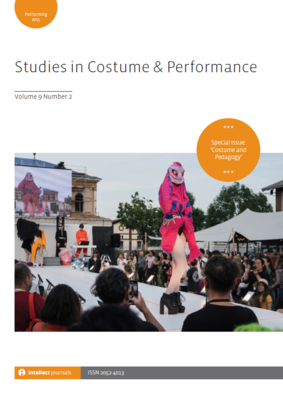
Call for Papers: Studies in Costume & Performance 7.2
Call for Papers: Studies in Costume & Performance 7.2
Special Issue: ‘Costume and Fairy Tales’
To download the full CFP, click here >> https://www.intellectbooks.com/asset/54851/1/CfP_SCP_7.2_2020.pdf
Costume plays an important part both in traditional fairy tales and in their adaptations in diverse media forms, especially in performing arts such as theatre, ballet, opera, and musical, but also in other media such as film, visual art, manga, theme parks, video games, and digital and social media. Clothes worn by characters in fairy tales function according to the internal narrative logic that constitutes and organizes the story-world, defining and transforming the wearers’ identities and social contexts. In this sense, fairy-tale clothes can be regarded as costume, defined as the kind of clothes that bear significance, within a staged, performed moment for an audience, ranging from traditional theatre to live art, through spoken, movement based, or sung performance. The ubiquitous persistence of fairy tales in popular cultures across the globe renders them a means to express social, cultural and psychological anxieties, evoking ethical dimensions of individual and collective struggles. As such, the way characters are embodied through their clothes bears significant narrative and performative potential in layering of meanings in performance making.
Equally, iconic fairy tale characters may float away from their narrative roles and be found to be expressing key themes in contemporary performance-based artistic practices. For example, Korean-born photographer Chan-Hyo Bae in his Existing in Costume series (2006-) casts himself in the roles of princesses in European fairy tales such as Cinderella and Sleeping Beauty by wearing authentic dresses worn by ruling-class women in eighteenth-century England, thereby foregrounding the physical and metaphorical tension between the male Asian body and those kinds of historical costumes which evidence the Eurocentric colonial norms still dominant in today’s globalized culture.
While the relationship between fashion and the fairy tale has been examined in the fields of fashion studies and fairy-tale criticism, the concept of costume in the fairy tale has not yet been sufficiently explored. We believe that an interdisciplinary, cross-cultural approach to this topic will offer fresh insight into the fields of costume studies, fairy-tale studies, performance studies, and, more broadly, studies of art, narrative, and culture across time, space, and discipline.
Topics may include, but are not limited to:
• Costume and gender/sexuality/race/class/ethnicity/age in fairy tales
• Costume and multispecies entanglement in fairy tales
• Costume in ballet/opera/theatre/musical/film/visual adaptations of fairy tales
• Costume and metamorphosis in fairy tales
• Costume and liminality in fairy tales
• Post-colonial implications of costume in fairy tales
• Costume and globalisation of fairy tales.
This issue of the journal invites full-research articles (4000–5000 words), visual essays (1000–2500 words with emphasis on visual evidence), research reports (2500–4000 words), analyses of research documents or ‘in-conversations’ with artists, designers, or scholars (2000–4000 words), and reviews of events and of new publications.
Submission deadline for all manuscripts: 31 December 2021
Publication: December 2022
Please send any questions regarding submissions to: Mayako Murai: mayakomurai@me.com

